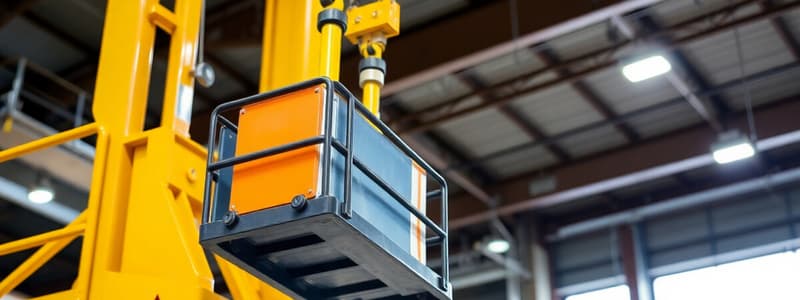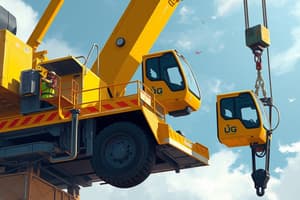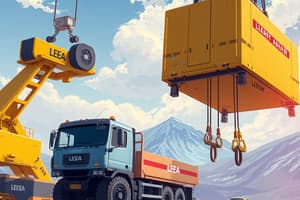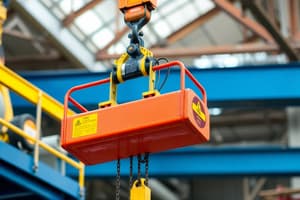Podcast
Questions and Answers
What is a potential consequence for employers not managing health and safety properly?
What is a potential consequence for employers not managing health and safety properly?
- Increased employee motivation
- Higher sales turnover
- Improved production efficiency
- Loss of output (correct)
Which of the following is NOT a consequence of poor health and safety management?
Which of the following is NOT a consequence of poor health and safety management?
- Reduced profitability
- Increased insurance costs
- Negative public relations
- Higher customer satisfaction (correct)
The Health and Safety at Work Act is specific to which country?
The Health and Safety at Work Act is specific to which country?
- United Kingdom (correct)
- Canada
- United States
- Australia
The Act that forms the foundation for health and safety legislation in Australia is known as?
The Act that forms the foundation for health and safety legislation in Australia is known as?
Which term refers to a rule established by an authority regarding health and safety?
Which term refers to a rule established by an authority regarding health and safety?
What does the Occupational Safety and Health Act of 1970 primarily address?
What does the Occupational Safety and Health Act of 1970 primarily address?
What is a financial consequence of not managing employee health and safety effectively?
What is a financial consequence of not managing employee health and safety effectively?
Which of the following best describes the relationship between health and safety culture and public perception?
Which of the following best describes the relationship between health and safety culture and public perception?
What is the primary purpose of Approved Codes of Practice (ACoPs)?
What is the primary purpose of Approved Codes of Practice (ACoPs)?
Which statement accurately reflects the role of ACoPs in legal proceedings?
Which statement accurately reflects the role of ACoPs in legal proceedings?
Who has the authority to issue Approved Codes of Practice?
Who has the authority to issue Approved Codes of Practice?
What is the meaning of 'Duty Holder' in a workplace context?
What is the meaning of 'Duty Holder' in a workplace context?
Which of the following does NOT fall under the types of Codes of Practice?
Which of the following does NOT fall under the types of Codes of Practice?
How are ACoPs viewed in the context of criminal proceedings?
How are ACoPs viewed in the context of criminal proceedings?
What is the significance of ACoPs beyond providing guidance?
What is the significance of ACoPs beyond providing guidance?
Which is considered a vital practice within the industry discussed?
Which is considered a vital practice within the industry discussed?
What is the primary purpose of standards?
What is the primary purpose of standards?
Who typically creates standards?
Who typically creates standards?
What do ISO standards represent?
What do ISO standards represent?
What is a Code of Practice?
What is a Code of Practice?
What is the quasi-legal status of compliant standards?
What is the quasi-legal status of compliant standards?
What happens after the review of a proposed standard?
What happens after the review of a proposed standard?
Which of the following is NOT a type of standard mentioned?
Which of the following is NOT a type of standard mentioned?
Why are standards designed for voluntary use?
Why are standards designed for voluntary use?
Who is ultimately responsible for ensuring legal obligations are met when a duty holder delegates their responsibilities?
Who is ultimately responsible for ensuring legal obligations are met when a duty holder delegates their responsibilities?
What must a duty holder ensure about the employees to whom they delegate tasks?
What must a duty holder ensure about the employees to whom they delegate tasks?
Which of the following responsibilities does legislation NOT place on suppliers?
Which of the following responsibilities does legislation NOT place on suppliers?
What is the primary reason for placing responsibilities on manufacturers and suppliers regarding lifting equipment?
What is the primary reason for placing responsibilities on manufacturers and suppliers regarding lifting equipment?
What does a duty holder need to do to ensure an external organization is competent?
What does a duty holder need to do to ensure an external organization is competent?
Which of the following is NOT a responsibility of employees with respect to using lifting equipment?
Which of the following is NOT a responsibility of employees with respect to using lifting equipment?
What must manufacturers ensure regarding foresight of hazards?
What must manufacturers ensure regarding foresight of hazards?
What is a consequence for a duty holder who fails to properly assess the competency of their personnel?
What is a consequence for a duty holder who fails to properly assess the competency of their personnel?
What is one of the employer's duties regarding equipment maintenance?
What is one of the employer's duties regarding equipment maintenance?
Which standard guides the essential safety requirements for manufacturers of lifting equipment?
Which standard guides the essential safety requirements for manufacturers of lifting equipment?
What is NOT a responsibility of equipment manufacturers?
What is NOT a responsibility of equipment manufacturers?
What does the term 'Competent Person' refer to in legislation?
What does the term 'Competent Person' refer to in legislation?
What is a key principle underlying manufacturer's responsibilities?
What is a key principle underlying manufacturer's responsibilities?
What should a 'Competent Person' be ready to do according to their role?
What should a 'Competent Person' be ready to do according to their role?
Which of the following is NOT indicated as a duty of employers regarding equipment?
Which of the following is NOT indicated as a duty of employers regarding equipment?
What is the main goal of the LEEA Code of Practice (COPSULE)?
What is the main goal of the LEEA Code of Practice (COPSULE)?
What is the purpose of a thorough examination of lifting equipment?
What is the purpose of a thorough examination of lifting equipment?
Which of the following describes a lifting accessory?
Which of the following describes a lifting accessory?
Why is it essential to note repairs needed during equipment inspection?
Why is it essential to note repairs needed during equipment inspection?
Which among the following is NOT considered a lifting accessory?
Which among the following is NOT considered a lifting accessory?
What role does a competent person play in the thorough examination of lifting equipment?
What role does a competent person play in the thorough examination of lifting equipment?
Why is it important to have a robust inspection regime for lifting accessories?
Why is it important to have a robust inspection regime for lifting accessories?
What is a lifting appliance generally defined as?
What is a lifting appliance generally defined as?
Which of the following is an essential benefit of regular inspections of lifting equipment?
Which of the following is an essential benefit of regular inspections of lifting equipment?
Flashcards
Approved Code of Practice (ACoP)
Approved Code of Practice (ACoP)
Provides detailed guidance on how to comply with health and safety legal requirements.
Recommended Code of Practice (RCoP)
Recommended Code of Practice (RCoP)
Guidance on best practices for health and safety, not legally binding.
Code of Practice
Code of Practice
Guidance documents that describe how to meet health and safety standards.
Duty Holder
Duty Holder
Signup and view all the flashcards
Health and safety regulations
Health and safety regulations
Signup and view all the flashcards
Trade/Professional Codes
Trade/Professional Codes
Signup and view all the flashcards
Technical Publications
Technical Publications
Signup and view all the flashcards
Safety Information Sheets
Safety Information Sheets
Signup and view all the flashcards
Consequences of poor health and safety management
Consequences of poor health and safety management
Signup and view all the flashcards
Loss of output
Loss of output
Signup and view all the flashcards
Lowered morale and motivation
Lowered morale and motivation
Signup and view all the flashcards
Health and safety culture
Health and safety culture
Signup and view all the flashcards
Legislation
Legislation
Signup and view all the flashcards
UK Health and Safety at Work Act
UK Health and Safety at Work Act
Signup and view all the flashcards
Occupational Safety and Health Act (USA)
Occupational Safety and Health Act (USA)
Signup and view all the flashcards
Regulations (health and safety)
Regulations (health and safety)
Signup and view all the flashcards
Standards
Standards
Signup and view all the flashcards
Standards' Purpose
Standards' Purpose
Signup and view all the flashcards
Standard Creation
Standard Creation
Signup and view all the flashcards
Standard Types
Standard Types
Signup and view all the flashcards
Code of Practice Purpose
Code of Practice Purpose
Signup and view all the flashcards
Standard Stages
Standard Stages
Signup and view all the flashcards
Quasi-legal status
Quasi-legal status
Signup and view all the flashcards
Thorough Examination
Thorough Examination
Signup and view all the flashcards
Lifting Equipment
Lifting Equipment
Signup and view all the flashcards
Lifting Accessory
Lifting Accessory
Signup and view all the flashcards
Lifting Appliance
Lifting Appliance
Signup and view all the flashcards
Periodic Examination
Periodic Examination
Signup and view all the flashcards
Competent Person
Competent Person
Signup and view all the flashcards
Why inspect lifting equipment regularly?
Why inspect lifting equipment regularly?
Signup and view all the flashcards
What do the examinations involve?
What do the examinations involve?
Signup and view all the flashcards
Employer's Equipment Responsibilities
Employer's Equipment Responsibilities
Signup and view all the flashcards
What does EN ISO 12100 cover?
What does EN ISO 12100 cover?
Signup and view all the flashcards
Manufacturer's Duty
Manufacturer's Duty
Signup and view all the flashcards
What is a Competent Person's role?
What is a Competent Person's role?
Signup and view all the flashcards
LEEA COPSULE
LEEA COPSULE
Signup and view all the flashcards
Delegation of Duty
Delegation of Duty
Signup and view all the flashcards
What are the advantages of COPSULE?
What are the advantages of COPSULE?
Signup and view all the flashcards
Duty Holder's Responsibility After Delegation
Duty Holder's Responsibility After Delegation
Signup and view all the flashcards
What are the benefits of a Competent Person?
What are the benefits of a Competent Person?
Signup and view all the flashcards
Vetting External Organizations
Vetting External Organizations
Signup and view all the flashcards
Employee Responsibilities
Employee Responsibilities
Signup and view all the flashcards
Manufacturer's Responsibilities
Manufacturer's Responsibilities
Signup and view all the flashcards
Importer/Distributor Responsibilities
Importer/Distributor Responsibilities
Signup and view all the flashcards
Focus of Legislation on Safety
Focus of Legislation on Safety
Signup and view all the flashcards
Study Notes
Foundation Certificate (FOU) (Global) Workbook
- This course provides essential knowledge for students pursuing Diploma qualifications.
- It's a prerequisite for accessing LEEA's Diploma qualifications.
- Core areas covered: legislation, regulations, standards, best practice related to lifting equipment, definitions, controlling risks, materials science, units of measure, basic machines, manufacturers' verification, rating of lifting equipment, and types of lifting equipment.
- Successful completion enables students to outline the legal requirements of the lifting equipment industry, choose appropriate standards and best practices, identify different lifting equipment, describe materials and manufacturing methods, and understand manufacturer verification procedures.
Legislation and Regulations
- Legislation and regulations govern the lifting equipment industry.
- Legal frameworks establish rules and govern decision-making, agreements, and laws.
- Employers are primarily responsible for health and safety at work, but employees also have responsibilities under health and safety law.
- Employers have a moral duty of care to ensure appropriate working conditions.
- Consequences of failing to manage health and safety can include unsafe working conditions, loss of output, lowering of morale and motivation, loss of sales turnover and profitability, negative PR, fines, damages, legal costs, and insurance.
Regional Safety Frameworks
- Each country has a similar form of health and safety framework.
- The frameworks may have different names and structures, but their purpose is to protect everyone's health and safety in the workplace.
- Examples include the UK's Health and Safety at Work Act, Australia's model WHS Act, and the USA's Occupational Safety and Health Act of 1970.
Standards
- Standards are published specifications for common language and precise criteria regarding materials, products, methods, and services.
- Standards promote consistent practices and increase goods/service reliability and effectiveness.
- Standards are not regulations but often have quasi-legal status due to their widespread recognition.
- Common standards include ISO, BSI, and ASME standards.
- Standards are usually created by subject matter experts forming a committee.
- Four stages of creating a standard: discussion, draft, comments, and publication.
Codes of Practice
- Codes of Practice (ACoPs) provide detailed guidance on how to meet general duty requirements stated in Acts.
- ACoPs are issued by relevant authorities and are based on public consultation with stakeholders.
- ACoP contraventions are admissible in court as evidence.
- ACoPs clarify their status.
Duty Holder
- Duty holder is the person responsible for lifting equipment they own or use (generally employers/self-employed).
- Duty holder obligations may be delegated to others, though they remain responsible.
- Duty holders are responsible for the legal and safety obligations of those who are tasked with the work.
Competency
- Competency involves knowledge, experience, training, skills, and ability to perform specific duties.
- Competent personnel are knowledgeable and experienced with the necessary skills and ability to do the job correctly.
- Competency is required to determine suitability for specific duties.
Factor of Safety
- Factor of safety (FOS) is a working coefficient that provides additional strength redundancy for components, compensating for overload and deterioration.
- Inspection is crucial for maintaining safe working conditions.
- Inspection levels include pre-use, interim, and thorough examinations.
Lifting Equipment
- Lifting equipment encompasses all types of lifting accessories, appliances, and aids, including lifting gear, tackle or rigging equipment.
- Lifting accessories are used to attach loads to appliances.
- Lifting appliances include cranes, hoists, and jacks.
Manufacturers' Responsibilities
- Manufacturers are responsible for ensuring equipment complies with safety requirements and are compliant with the necessary legal or regulatory frameworks.
- Manufacturer documentation (certificate, record of tests, or statement of conformity) ensures equipment complies with standards during manufacturing, proving compliance and safety.
Studying That Suits You
Use AI to generate personalized quizzes and flashcards to suit your learning preferences.




